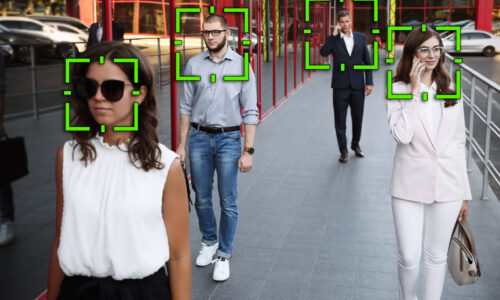Say goodbye to key cards. Mobile credentials and biometric identity solutions are upending the traditional access control model. Why choose one over the other? Here, we’ll examine how they compare.
User Convenience: We use our phones for everything: paying at the cash register, attending concerts and sporting events, presenting digital boarding passes, controlling home appliances, and so much more! It’s only logical that we should use them to enter and move freely throughout our workplaces. Compared to an access card, we’re far less likely to lose or forget to bring our phone to work; we’ll head back home to get it rather than go an entire day separated. Our phones go where we go, all day, every day.
So do our eyes, faces, fingers, or palms, all of which are common biometric modalities.
Mobile credentials may reduce the frequency of employees getting accidentally locked out, but biometrics eliminate these occurrences completely. There’s no risk of workers “running out to get something” and realizing too late that their phone is sitting on their desk. Or, in the terrible event that the phone gets lost, stolen, or broken that they can’t get into work the next day. There’s also the possibility that a phone’s charge runs out. No battery; no credentials.
Convenience is also measured by “seamlessness.” Technology is best when it does its job so well that we’re barely aware of it.
Like cards and fobs, phones usually must be held within close proximity to a reader to activate its controller. In some cases, depending on the manufacturer, the phone also must be unlocked and an app or digital wallet opened. This requires planning ahead – retrieving the phone from one’s bag or pocket and having it ready to present at the door.
Certain biometric solutions can reduce or eliminate such hassles at the reader.
Touchless palm and fingerprint readers still require the availability of a hand – and a glove-free one at that. For seamlessness, they’re not much of an improvement over smartphones. Face biometrics are hands-free, although glasses, scarves, masks, and hats may interfere with identification. The iris is most convenient; iris cameras require merely a glance from the enrolled user to verify their identity. Our eyes are always visible regardless of what we wear, and iris cameras can work through glasses and even most sunglasses. Therefore, when it comes to user convenience, iris biometrics outperform all other options, hands down. (Pun intended!)
System Installation and Management: Mobile credentialing is now available with almost all commercial access control solutions. For some manufacturers, it’s the primary operating mode. With others, it’s an option. Companies that have a traditional access control infrastructure in place and wish to upgrade to mobile credentialling must install new readers that support Bluetooth and/or NFC (Near Field Communication).
From an administrative perspective, issuing mobile credentials to employees is faster than issuing cards. Assuming employees are already entered within a companywide database, not much more is required than typing in an associated phone number.
Unlike Bluetooth readers, biometric readers are not yet available directly from most of today’s access control manufacturers. However, any professional systems integrator can easily integrate a third-party biometric identity solution with an access control platform. Installing biometric readers at doorways is no more difficult than wiring security cameras.
Enrolling users requires nothing more than taking an initial “reading” and associating it with their employee data, after which the biometric signatures are shared automatically with the access control software. To verify one’s identity, users must provide a “match” to their biometric signature. From a security management perspective, the access control software operates no differently than if key cards were in use.
Security: Whether using a mobile or biometric access control solution, it’s imperative that the manufacturer provides end-to-end encryption and employs cybersecurity best practices at all levels. That said, fundamental differences make biometric systems – and iris solutions specifically – a far more secure option.
Mobile credentials are only as secure as the phones on which they reside. If a spouse, friend, or acquaintance knows our password (or can easily guess it) and takes our phone, they now have access to our workplace. The same risks exist for any phone that’s left unlocked and unattended. While we hope that most people take their phone security seriously, it’s something that’s beyond the control of corporate security management.
Biometric credentials cannot be shared. Furthermore, the iris is so unique that iris-based systems can be safely deployed by companies with hundreds of thousands of employees. A false match occurs less frequently than once in one million.
Price: Mobile access control is currently the more cost-effective option when price is calculated purely based on readers and licensing fees. However, many other factors contribute to total cost-of-ownership and ultimate ROI. Companies with high-risk exposure may figure that the increased security afforded by biometric access control justifies the incremental expense of the technology. Biometrics also become more price-competitive in situations with only a few secured entryways but many employees, like an e-commerce warehouse.
The price of biometric solutions has also come down dramatically in recent years. Service-based pricing models can significantly reduce upfront costs, with the expense categorized as an OPEX and spread over months or years. Companies that desire the benefits of biometric access control but have previously found the price beyond their budget would be well-served to revisit the possibility. The market has evolved!
Summary: Mobile and biometric solutions offer many benefits over traditional access control, and their popularity will only grow as public demand for greater convenience and security drive market preferences. Most security integrators are familiar with the selling points of mobile credentialling because mobile apps are commonly available as part of today’s access control systems. However, customers are best served when presented with the benefits of both options, and they can make an educated choice based upon careful analysis of what each can offer. In many instances, companies will find that biometrics is clearly the superior solution.




